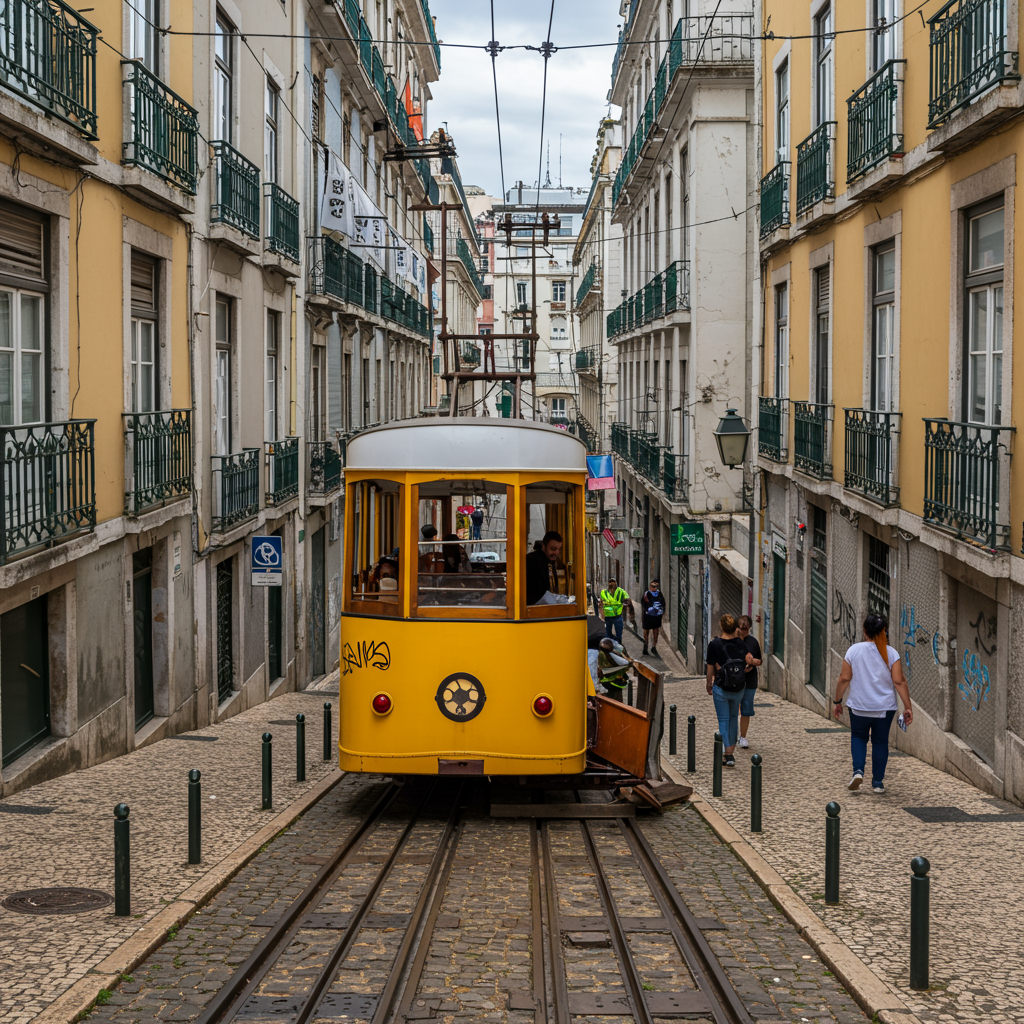The vibrant heart of Lisbon, a city celebrated for its historic charm and welcoming spirit, was shaken by a tragic streetcar derailment. On Wednesday, September 3, 2025, the beloved Elevador da Glória, a funicular popular with both locals and international visitors, careened off its tracks. This devastating Lisbon streetcar derailment resulted in the deaths of 16 people and left 21 injured, five critically. Prime Minister Luis Montenegro described the incident as “one of the biggest tragedies of our recent past,” underscoring its profound impact. The incident’s international scope became immediately clear, with police confirming that a majority of those killed were foreign nationals, turning a local accident into a global sorrow.
The Tragic Derailment of a Lisbon Icon
The accident, which occurred around 6 p.m. during the evening rush hour, plunged downtown Lisbon into chaos. Witnesses reported seeing the distinctive yellow-and-white streetcar, technically a funicular, appear “out of control” as it descended a steep hill. It ultimately crashed into a building where the road bends, leaving a scene of crumpled wreckage. Emergency services swiftly responded, working through the night to assist the injured and recover victims from the mangled vehicle. The Elevador da Glória, classified as a national monument, was reportedly packed with passengers, highlighting its appeal as a cherished part of Lisbon’s urban landscape. Its short, picturesque route up a city street makes it a magnet for long lines of tourists eager for the unique experience.
A Global Impact: Victims from Across the World
The human cost of the Lisbon streetcar derailment quickly transcended national borders. Police confirmed that 11 of the 16 fatalities were foreign citizens. The deceased included five Portuguese nationals, three British citizens, two Canadians, two South Koreans, one American, one French, one Swiss, and one Ukrainian. This diverse list of victims underscored Lisbon’s status as a premier global tourist destination, attracting approximately 8.5 million visitors in the preceding year alone.
Forensic identification efforts were crucial in confirming these nationalities. Notably, an initial report mistakenly identified a German man as deceased; he was later found alive and recovering in a Lisbon hospital. Among the identified Portuguese victims were André Marques, the streetcar’s brakeman, and four dedicated staff members from Santa Casa da Misericórdia, a prominent national charitable organization whose headquarters are near the funicular’s route. The injured also represented a multinational group, including individuals from Spain, Israel, Portugal, Brazil, Italy, and France, further emphasizing the tragedy’s widespread ripple effects.
The Historic Elevador da Glória: A Beloved Landmark
The Elevador da Glória is more than just a mode of transport; it’s a living piece of Lisbon’s history. Inaugurated in 1885, the funicular has been an integral part of the city’s infrastructure for 140 years. The specific streetcar involved in the accident, in service since 1914, holds national monument status. This electric funicular, harnessed by steel cables, can carry over 40 people, both seated and standing, on its curved, traffic-free path. Its iconic status and the short, scenic journey it offers have made it an indispensable experience for many visiting Portugal’s capital. The sheer volume of people who rely on or aspire to ride this funicular daily underscores the profound sense of loss and disruption caused by the tragedy.
Intensive Investigations Seek Answers
In the wake of the devastating crash, multiple agencies launched intensive investigations to determine its precise cause. Prime Minister Luis Montenegro, leading the nation in mourning, emphasized the government’s commitment to understanding what led to “one of the biggest tragedies of our recent past.”
The Office for Air and Rail Accident Investigations, a government body, concluded its analysis of the wreckage. They were initially set to release a preliminary technical report on Friday. However, due to delays in coordinating procedures with other involved bodies, the report’s publication was postponed until Saturday, September 6, 2025. This initial report is expected to shed light on some technical aspects of the incident. Separately, Chief Police Investigator Nelson Oliveira announced that a broader preliminary police report, encompassing a wider scope of inquiry, is anticipated within 45 days. The wreckage of the streetcar has been secured and placed into police custody as evidence. Carris, the company responsible for operating Lisbon’s streetcars and buses, also initiated its own internal investigation, adding another layer to the comprehensive probe.
Unanswered Questions and Safety Concerns
Officials are treading carefully amidst speculation about the crash’s cause. Lisbon Mayor Carlos Moedas stressed that talk of factors like a faulty brake or a snapped cable was “mere speculation,” emphasizing the city’s urgent need for definitive answers based on facts. The streetcar had undergone a scheduled full maintenance program just last year, according to Carris CEO Pedro de Brito Bogas. He also stated that daily 30-minute visual inspections were routine, with the last one conducted just nine hours before the derailment. However, when questioned, Bogas did not provide specifics on the visual inspection process or confirm if the steel cables were explicitly tested. In a proactive safety measure, Lisbon’s City Council promptly halted operations of three other funicular streetcars for immediate inspections. This decision reflects a serious commitment to passenger safety across the city’s historic transport network.
A City in Mourning, Tourists in Shock
The impact of the Lisbon streetcar derailment extended far beyond the immediate crash site. Portugal declared Thursday, September 4, 2025, a national day of mourning. Hundreds gathered for a somber Mass at Lisbon’s majestic Church of Saint Dominic, a poignant tribute to the victims. Dignitaries including Prime Minister Montenegro, President Marcelo Rebelo de Sousa, and Mayor Moedas attended, many dressed in black. Prime Minister Montenegro’s words, “This tragedy… goes beyond our borders,” resonated deeply, acknowledging the global dimension of the loss.
The incident profoundly affected tourists, many of whom frequent the funiculars. Felicity Ferriter, a 70-year-old British tourist, described hearing a “horrendous crash” from her nearby hotel. She and her husband had planned to ride the Elevador da Glória the very next day, making the tragedy chillingly personal. “It was to be one of the highlights of our holiday,” she reflected, adding, “It could have been us.” Francesca di Bello, a 23-year-old Italian tourist, had ridden the funicular just hours before the derailment. After witnessing the wreckage, she declared emphatically that she would “definitely not” ride a funicular again in Portugal or anywhere else. These reactions highlight the immediate and significant blow to tourist confidence in Lisbon’s historic transport systems.
Beyond the Immediate: Broader Implications for Urban Transport Safety
The Lisbon streetcar tragedy serves as a stark reminder of the complexities inherent in maintaining historic urban transport infrastructure, particularly in popular tourist destinations. Cities like Lisbon often grapple with the challenge of preserving heritage while ensuring modern safety standards for millions of users. This incident will undoubtedly prompt a deeper re-evaluation of maintenance protocols, inspection frequencies, and emergency response mechanisms for similar funiculars and trams worldwide. The emphasis on daily visual inspections, as described by Carris, may come under scrutiny, potentially leading to calls for more rigorous, technically comprehensive assessments. Balancing the charm of century-old systems with the imperative of passenger safety is a delicate act, and this derailment will contribute to a global conversation on best practices for urban transport safety.
Frequently Asked Questions
What exactly is the Elevador da Glória, and why is it so popular?
The Elevador da Glória is a historic funicular in Lisbon, Portugal, officially classified as a national monument. Operating since 1885, with the specific streetcar involved in the derailment in service since 1914, it’s a unique electric tram system. It ascends a steep, curved, traffic-free street, offering a short yet scenic ride up a hill in downtown Lisbon. Its popularity stems from its iconic yellow-and-white appearance, its historical significance, and the panoramic views it provides, making it a must-do experience for both locals and the approximately 8.5 million tourists who visit Lisbon annually.
Which official bodies are investigating the Lisbon streetcar derailment?
Multiple official bodies are conducting investigations into the Lisbon streetcar derailment. These include the Portuguese police, who are preparing a broader preliminary report expected within 45 days, and the government’s Office for Air and Rail Accident Investigations, which has analyzed the wreckage and is slated to release a preliminary technical report. Additionally, Carris, the company that operates Lisbon’s streetcars and buses, has launched its own internal investigation into the incident. These overlapping probes aim to provide a comprehensive understanding of the crash’s causes.
How has the Lisbon streetcar tragedy impacted tourist perceptions of funicular safety?
The Lisbon streetcar tragedy has significantly shaken tourist confidence in funicular safety. Testimonies from tourists, such as a British visitor who narrowly missed riding the ill-fated funicular and an Italian tourist who swore off riding funiculars again, highlight a palpable sense of shock and fear. The incident has cast a shadow over what was once a quintessential Lisbon experience, potentially leading many travelers to reconsider their use of such historic transport systems. This shift in perception could prompt tourism boards and transport operators to proactively address safety concerns to reassure visitors.
Conclusion
The Lisbon streetcar derailment represents a profound tragedy that has left an indelible mark on Portugal and the global community. With 16 lives lost, a majority being foreign nationals, the incident underscores the far-reaching impact of urban transport accidents in a highly connected world. As Lisbon observes a period of mourning, the focus remains firmly on the ongoing investigations by multiple agencies. The city, its officials, and the international community await the findings that will clarify the causes of this devastating event. The ultimate goal is not only to understand what happened on that fateful Wednesday evening but also to implement measures that ensure such a tragedy never recurs, safeguarding the future of Lisbon’s beloved historic transport and the millions who ride it.



